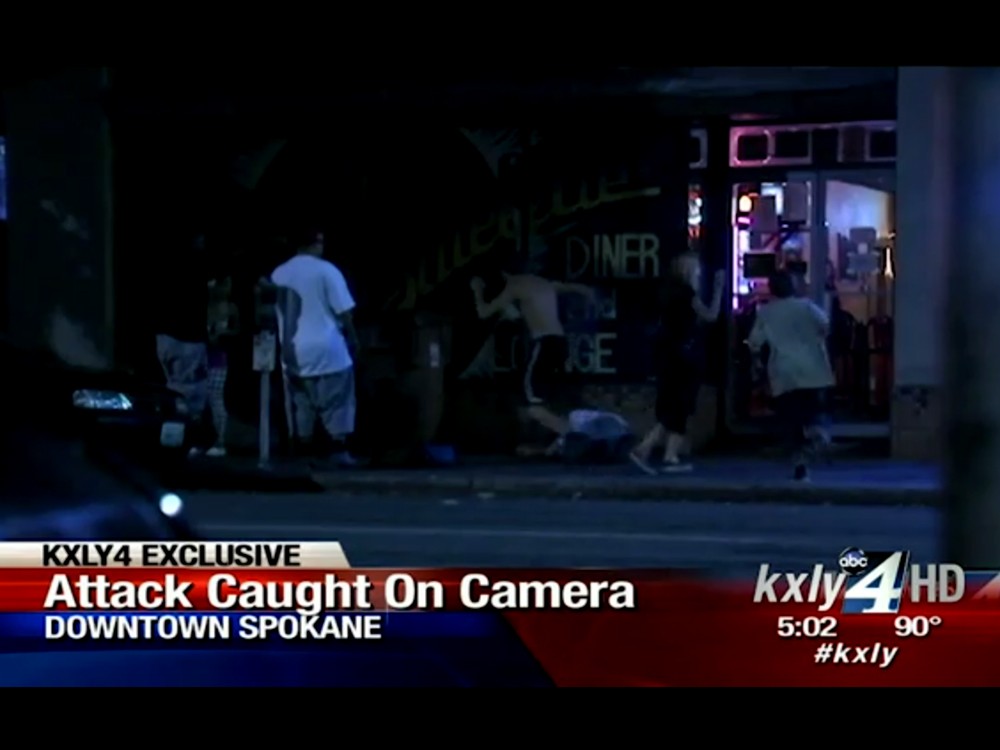“Now to a story you’ll see only on KXLY 4 News,” says Nadine Woodward, stone-faced, to the camera. “It shows how dangerous the streets of downtown Spokane have become.”
The station rolls its exclusive video of a “victim knocked unconscious when he was sucker-punched by a street kid” outside the Satellite Diner late one night in mid-September. Then comes a package from reporter Jeff Humphrey in which he speculates the suspect may have been panhandling and then recounts the scene. “While the victim lies there unconscious,” he says, “the group returns to celebrate their cowardly act like they’ve just scored a touchdown.”
The station’s coverage is part of the spectrum of local media coverage bringing questions about downtown safety to the forefront of community and City Hall discussion, despite clear evidence that crime is down in the city’s core.
A story on KXLY.com introducing the video includes, without any authoritative or even anecdotal source, the assertion that “street kids [are] getting bolder and more violent as their acts go unpunished” and that “victims don’t like reporting that they’ve been bested by a group of kids, some of them not even old enough to drive.” The scene in the video — pleasure being taken in brutality — could haunt any viewer, but the station has used the footage, which Humphrey has since called “the beatdown,” in at least six other reports, including those about nonviolent issues like panhandling. Woodward called it part of a “teenage crime wave that seems to be spiraling out of control.” Humphrey has called young people downtown “ne’er-do-wells” and ended one story saying, “Street kids still run the night here in downtown Spokane.”
KREM and KHQ also have covered the issue, though from a count of their online story and video archives, with less fervor than KXLY. The Spokesman-Review ran a package of stories late last month about downtown’s “sullied image,” but columnist Doug Clark took a more alarmist tone, calling downtown an “open toilet” before detailing an hour-long walkabout he took to assess the state of things. Among his observations: stains on sidewalks, noisy skateboarders and 30 young people who told him they’re homeless. At one point he quotes from a Jeff Humphrey story, calling the area outside the Olive Garden “ground zero for rude, obscenity-shouting young people who have made loitering their full-time jobs.” By the end, Clark seems stunned by what his town has become, ending his column this way: “Time to leave this place of sadness and go somewhere to mourn for my city.” (In what seemed like a direct response, fellow Spokesman columnist Shawn Vestal then wrote a column about how he “walked through downtown Spokane — and lived to tell about it.”)
Social media extends the shelf life of these stories and creates an ongoing discussion where facts can fight for airtime. Media outlets’ questions about whether viewers and readers feel safe in downtown have created long comment threads where people rail against Spokane and “street kids.” Some say they don’t go downtown; others say they’ll go only if they’re armed. Blame shifts to bad parenting or bad governance; someone suggests shipping the kids to boot camp.
“I think the media’s trying to raise consciousness — I would hope that’s their motivation — for the challenges that confront us downtown,” says Police Chief Frank Straub. “So let’s take that as a positive. Sometimes in the process of raising consciousness, you are also fueling fear a little bit.”
Bridget Cannon, youth program director at Crosswalk, says she doesn’t believe young loiterers are a new problem.
“What’s different is the media coverage, and that’s tied into social media stuff,” she says. “Now you have video cameras on phones. Before you might have heard about an issue; now people pull out their phones and you have video. … When you have a video, that does create a whole different sort of perception.”


















